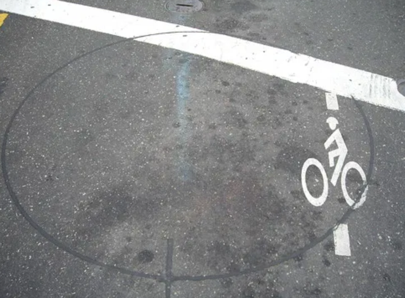
Inductive Loops
Inductive loops are still the standard for intersection vehicle detection and while some accommodations can be made to improve inductive loop detection for bicyclists, the ability for a loop to accurately differentiate a bicycle from a vehicle is still limited. Three primary factors impact bicycle detection at traffic signals using inductive loops:
1. Loop Construction
Traditional traffic loops are sawcut into the ground in various shapes, in general, the more cable installed in the pavement per loop, the more sensitive the loop can be adjusted to detect bicycles or motorcycles.
In-pavement vehicle loops may not offer enough sensitivity to detect a bicycle because they are sometime built narrow but long to detect more automobiles. Bicycle specific in-pavement loops are normally 6-FT x 6-FT with quadracircle loop construction that provides tightly spaced wiring that allows for more sensitive detection of metal on a bicycle. The ideal bicycle detection area on a quadracircle loop may be in the center or along one of the edges of the loop, wherever the most loop cable is concentrated. To help bicyclists position themselves properly on the loop, a Bicycle Detection Stencil is recommended, the stencils are available in preformed thermoplastic that can be melted onto the roadway and are available with a greenback option.
In-pavement loops are installed normally in pairs per lane or per approach. Ideal loop construction for bicycle detection places bicycle-specific loops within their own “homeruns” back to the traffic signal conduit network.
The loops that are saw cut into the pavement are spliced to Detector Lead-in Cables (DLC’s) that travel through the underground traffic signal conduit network to the traffic signal cabinet. The number of DLC’s will also impact detection capabilities for bicycles.
It is common in older traffic signals to have just one DLC per vehicle phase. If there are more than two lanes with several homerun loops spliced back to just one DLC, the detection sensitivity may not allow for proper bicycle detection because there are too many loops. Modern traffic signal design that utilizes traditional inductive loops will provide as many as one DLC per vehicle lane with dedicated DLC’s for bicycle detection.
The DLC’s are terminated at the traffic signal cabinet into Detection Channels. The traffic signal controller uses the detection channel inputs to assign right-of-way (green) to movements with demand.
BicycleDetection.com recommends that government agencies establish Standard Detection Channel Assignments to support traffic signal data sharing with connected and autonomous vehicles. Attached is a sample Detection Scheme for a video detection system, the same concepts can be used for inductive loop applications.
3. Loop Amplifiers
An inductive loop is basically a magnet that senses changes in its magnetic field when metal from a vehicle or bike are over it. The loop amplifier is what powers the field loops in the pavement through the DLC’s. All modern loop amplifiers offer sensitivity settings to help improve bicycle detection capabilities.









